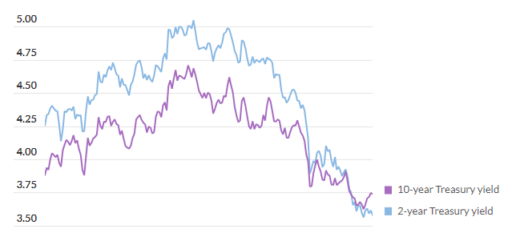Stock Market Turbulence: Yields on the Rise as Bond Traders Lead the Way
The Treasury sector, with a staggering $25 trillion under its sway, remained in control of the financial market on Thursday. Long-dated yields were once again approaching the 5% mark, influencing the equities market and aiding the resurgence of the greenback to recover this week’s losses.
Investors resumed a strong sell-off of government bonds, propelling 10- and 30-year yields to their highest levels in 16 years. Their substantial one-day jumps, the most significant in over a week, led to closing figures of 4.71% and 4.87%, respectively, at the end of the New York trading session. This disrupted a two-day rally observed until Wednesday, driven by speculations of a potential end to Federal Reserve rate hikes.
The release of hotter-than-expected September headline inflation figures from the consumer price index on Thursday increased the market’s expectation of a Federal Reserve rate hike in December. This data also cast doubt on policymakers’ reliance on the recent surge in long-term yields as an unofficial tool for tightening financial conditions, potentially negating the need for another rate hike, as many analysts have suggested.
“The bond market is still king,” affirmed Marc Chandler, the chief market strategist at Bannockburn Global Forex in New York. He pointed out that the post-CPI broad-based Treasury sell-off was boosting the dollar’s performance and exerting downward pressure on the stock market, which had seen a four-day rally.
While it remains too early to discern the exact impact of higher long-term rates on Fed policy, it is clear that the market’s response to September’s CPI inflation data undermines the central bank’s primary arguments for forgoing another rate hike, Chandler asserted.
One of the pivotal questions for policymakers pertains to the underlying cause of the recent dramatic surge in yields. Dallas Fed President Lorie Logan suggested that if it is primarily attributed to the strength of the U.S. economy, the Fed “may need to do more.” On the other hand, if the increase is driven by higher term premiums, it might reduce the necessity for raising the fed funds rate. Term premium signifies the extra compensation investors demand for holding a bond over its entire lifespan.
Since the Federal Reserve’s policy decision on September 20, which reiterated the theme of higher interest rates for a more extended period, 10- and 30-year Treasury yields saw substantial increases. However, with the bond market closed on Monday for Columbus Day and Indigenous Peoples Day, both rates saw temporary dips on Tuesday and Wednesday before ascending once again on Thursday.
According to Bannockburn’s Chandler, Thursday’s Treasury-market movements are driven primarily by inflation and the nation’s economic strength, rather than term premiums. He predicts that both rates will continue to test the 5% yield mark, considering the renewed ascent during the New York trading session. The demand seen earlier in the week for government debt, which pushed prices higher after the outbreak of conflict in the Middle East, is viewed as a short-lived “dead cat bounce.”
On Thursday, yields for Treasury securities ranging from 6 months to 30 years were broadly higher, with 10- and 30-year yields recovering all their Wednesday declines. The three major U.S. stock indices, DJIA, SPX, and COMP, concluded lower, while the ICE U.S. Dollar Index (DXY) rebounded 0.7%, effectively erasing most of its weekly losses. The movement of the dollar is influenced by investors’ perceptions of U.S. interest rates relative to other nations, while stocks tend to suffer due to the anticipation of higher business costs and less attractive returns compared to government bonds.
Simultaneously, fed funds futures traders priced in a 31.4% probability of a quarter-point Fed rate hike in December, potentially elevating the main interest-rate target to a range of 5.5%-5.75%. They also estimated a 32.1% likelihood of such a move by January, leading the policy-sensitive 2-year rate to reach an intraday high of 5.08% in New York trading.
The minutes of the Fed’s September 19-20 meeting, released on Wednesday, indicated that most policymakers believed that another rate increase would be appropriate at a future meeting, although they emphasized the need for caution. Fed Gov. Christopher Waller and Fed Vice Chair Philip Jefferson both indicated that the recent surge in Treasury yields had been performing some of the Federal Reserve’s work in slowing down the economy.
Economist Thomas Simons of Jefferies noted that policymakers had previously pointed to long-end yield increases as an effective tool for tightening conditions. However, the recent data release seems to challenge that notion, potentially increasing the likelihood of a more hawkish stance from Fed Chair Jerome Powell at the upcoming press conference and raising market expectations of a rate hike in December.




